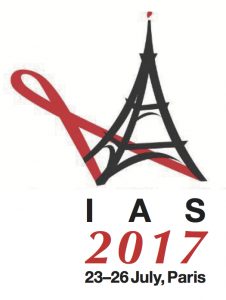Dolutegravir outperforms lopinavir/ritonavir second-line: interim results from the DAWNING study
10 August 2017. Related: Conference reports, Antiretrovirals, Treatment strategies, Treatment access, IAS 9th Paris 2017.
 Polly Clayden, HIV i-Base
Polly Clayden, HIV i-Base
Unsurprisingly, dolutegravir (DTG) was superior to lopinavir/ritonavir (LPV/r) in a comparison of DTG-based regimen vs WHO-recommended second-line. These data were presented as a late breaker at IAS 2017.
DAWNING is a non-inferiority, randomised, phase 3b, open label study conducted to evaluate the safety and efficacy of DTG + 2 NRTIs compared with LPV/r + 2 NRTIs in participants failing first-line ART of an NNRTI + 2 NRTIs.
Investigator-selected NRTIs had to include at least one that was fully active based on resistance testing at screening.
Eligible participants were on first-line NNRTI + 2 NRTI for at least six months and failing virologically with no primary resistance to PIs or INSTIs. The primary endpoint was proportion with viral load <50 copies/mL at week 48 (FDA snapshot; 12% non-inferiority margin). DAWNING enrolled from December 2014 to August 2016 and is ongoing.
After two of three pre-planned analyses, the study Independent Data Monitoring Committee (IDMC) conducted an ad hoc review of week 24 data and large subsets from weeks 36 and 48. They recommended discontinuation of the LPV/r arm due to differences in rates of virologic nonresponse and increasing differences in rates of virologic failure favouring the DTG arm. Participants in the LPV/r could switch to the DTG one.
DAWNING was a multi country study enrolling participants from 13 low- and middle-income countries (LMICs), including 168 from South Africa.
A total of 968 were screened and 624 randomised 1:1 to the two study arms: 11% vs 17% withdrew from the study and 53% vs 52% completed week 52, in the DTG and LPV/r arms respectively.
Participants were a median of 37 years of age, about a third were women, about 40% were of African origin, about half had CD4 count <200 cells/mm3 and 20% viral load >100,000 copies/mL.
In their second-line regimen across both arms, just over 40% received TDF + 3TC (or FTC) NRTI backbone and a further 40% AZT + 3TC (the remainder received TDF + AZT or ABC + 3TC or other).
At week 24, 82% of participants on DTG vs 69% on LPV/r achieved viral load <50 copies/mL: adjusted difference 13.8% (95% CI: 7.3 to 20.3), p=0.001.
The difference was mainly driven by lower rates of virologic non-response in the DTG arm: 12 vs 25%. There were more drug-related adverse events in the LPV/r arm, mainly due to higher rates of gastrointestinal disorders.
Interim data for weeks 36 and 48 were consistent with week 24 in favour of DTG, respectively: 78% (230/293) vs 69% (203/293), adjusted difference 9.8% (95% CI: 2.7 to 16.8); and 81% (199/247) vs 66% (161/245), adjusted difference 15.4% (95% CI: 7.8 to 23.1).
No participant receiving DTG + 2 NRTIs with confirmed virologic withdrawal (3%) developed primary INSTI or NRTI resistance mutations.
comment
The big question for LMICs is whether these results can be repeated without resistance testing.
Evidently of 968 people screened (624 randomised) about 30% (7–8% of the total) failed screening due to lack of at least one fully active NRTI.
It will be important to look how many of the participants receiving a TDF + 3TC or FTC backbone received the same in their first-line regimen.
Notably, in a subgroup of analysis by fully active NRTIs, participants with less than two did better than those with two, in both arms: 84 vs 73% and 74 vs 55% <50 copies/mL in the DTG and LPV/r arms respectively.
As low-cost generic DTG-based FDCs come to market next year more countries will be adopting DTG first-line. And as most desirable characteristics for an ART regimen (durability, tolerability, cost etc) favour DTG/TDF/XTC over PI- as well as NNRTI-based regimens, other groups beyond first-line could benefit too.
As well as ART-naive people, those who are suppressed on EFV-based regimens can be switched to DTG-based. But can unsuppressed people on EFV remain on TDF/XTC with DTG? And can those already suppressed on a LPV/r-based regimen also be switched to DTG/TDF/XTC?
The next set of ART optimisation studies plan to look at these questions.
Reference:
Aboud M et al. Superior efficacy of dolutegravir (DTG) plus 2 nucleoside reverse transcriptase inhibitors (NRTIs) compared with lopinavir/ritonavir (LPV/RTV) plus 2 NRTIs in second-line treatment: interim data from the DAWNING study. IAS 2017. 23–26 July 2017. Paris. Oral abstract TUAB0105LB.
http://programme.ias2017.org/Abstract/Abstract/5613

